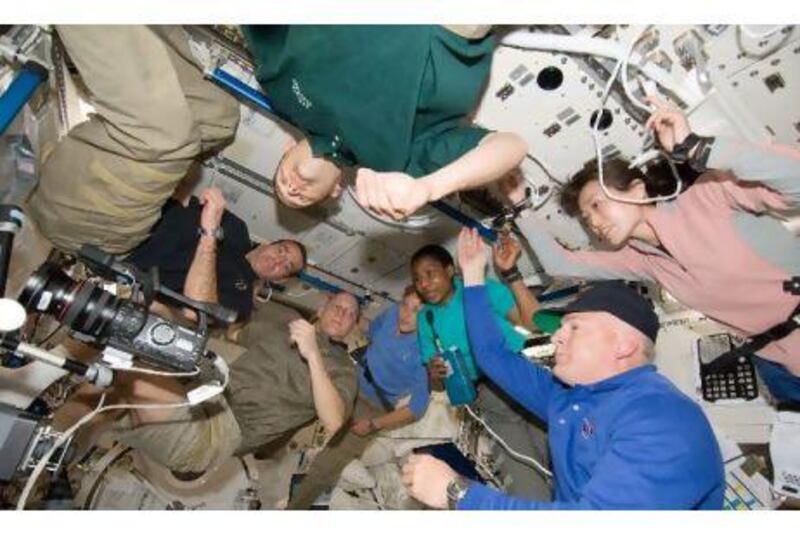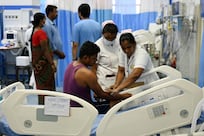Microgravity has long been a fertile field in which to conduct experiments on plants and animals that could lead to vaccines and medical breakthroughs. Now, the Emirates has plans to conduct its own in-orbit R&D. Erin Conroy reports from the ground floor
Sometimes, it helps to take the weight off your feet. But as scientists have explored the effects of microgravity, they have found many puzzles - not least of which is that of the spiral fire moss.
While most earthbound plants tend to grow upwards, away from gravity and towards a light source, moss hovers close to the ground. It does this, it is thought, thanks to heavy starch particles in cells in the tips of its filaments.
Without gravity weighing those particles down, scientists had expected the moss, Ceratodon purpureus, to grow in a confused and erratic pattern - but instead it did something strange. The tendrils grew outwards in tidy clockwise spirals.
Researchers have been studying the internal structure of moss cells on Nasa space shuttles for a better understanding of gravity's role in cell growth and distribution, but have been perplexed by the unexplained, seemingly choreographed swirls.
It might be that in the absence of gravity those heavy particles that normally weigh the filaments down tend to clump together. That might be the cue for intracellular signalling, causing the filaments to curve in a clockwise direction.
Or it might not; there may be another, as yet mysterious mechanism at play.
Questions like this, though, could soon be addressed as part of the UAE's space programme, as it eyes the commercial potential of microgravity research.
In its latest discussions with an international spaceflight company for human flight, the Emirates Institution for Advanced Science and Technology (EIAST) said it intended to incorporate a commercial laboratory for in-orbit research and development. This research is currently conducted almost exclusively on Nasa spacecraft.
And officials say a lab focusing on advanced biotechnology could help subsidise the cost of flying "tourists" into space.
While there are other ways of conducting research in zero- or low-gravity environments, they are hard to sustain for more than a few minutes or even seconds. Putting a lab in orbit gives experiments as much time as they need.
Proteins, for example, crystallise more perfectly in zero gravity, allowing researchers to study the chemical compositions of three-dimensional cell structures. Detailed knowledge of a protein's shape, functions and behaviour is vital for developing vaccines to target specific human, animal and plant diseases.
Tissue cultures suspended in microgravity have more freedom to grow than they would in a flat Petri dish. They are usually larger and better organised, and mostly free of defects caused by a gravitational pull.
While microgravity shows much promise in the quest to develop preventive medicines, it is being used in other applications, including in the research of fluid physics for oil recovery.
"In addition to continuing on our focus of satellite and space research services that will significantly enhance the quality of life in the UAE, EIAST is also exploring new avenues for strengthening our footprint in the global space research industry ... and its practical applications for the benefit of humanity," said Ahmed al Mansoori, the institution's general director.
EIAST signed a memorandum of understanding with the American space technology company Bigelow Aerospace in January.
"This is a very new field, which is why, in many ways, it is perfect for the UAE as a ground-floor opportunity to get the needed infrastructure and expertise in the area to become leaders in the field," said Mike Gold of Bigelow Aerospace.
The idea of conducting microgravity research in the Emirates is not new.
Sir Richard Branson's Virgin Galactic commercial space travel company, which has plans to build a spaceport in Abu Dhabi, has said its in-progress SpaceShipTwo will be a platform for microgravity research. However, experiments on its flights would have to be conducted within a matter of minutes.
Abu Dhabi-based Aabar Investments has a 32 per cent stake in Virgin Galactic.
The Japanese and European space agencies have conducted experiments under microgravity conditions, and Russia has begun to look at the area as a promising component of its space programme.
So far, almost all the research in this field has been conducted by governments and universities - but commercial opportunities are beginning to emerge.
An American biotech company, Astrotech, is the only corporate venture using manned in-orbit labs for vaccine development, doing so onboard the International Space Station (ISS).
"We have proven that conducting certain research in microgravity induces key changes within organisms that are critical to the drug-discovery process, which indicates that microgravity is a very promising platform for new drug discovery," said Scott Haywood, a spokesman for the company's space biotechnology arm, Astrogenetix.
A change in gravity can mean different pressures being exerted on a cell's sack-like membrane; the changes can be sensed by the regulatory structures within the cell, which could act as a trigger for genes being switched on or off.
This would result in different proteins being produced, which could cause the cell to grow or behave in a manner unlike that seen in normal gravity.
Astrogenetix has already discovered a vaccine candidate for salmonella and is conducting research on the superbug MRSA, which is the cause of several potent infections.
Microgravity research has been done on a smaller scale using drop towers and parabolic, or elliptic, flight, which provide a nearly weightless environment, albeit for short periods of time.
Drop-tower experiments, done primarily in Japan, provide between five and seven seconds of microgravity and require a tall structure from which to drop the experiment.
In parabolic flights, an aeroplane follows an elliptic flight path that produces a sense of weightlessness. Known colloquially as the "vomit comet" because of the flights' effects on passengers, it provides about 20 seconds of low-gravity conditions. However, the strong vibrations of the plane's engines can cause problems for some experiments, upsetting the delicate processes of growing cells.
These blink-and-you-miss-them experiments are fine for some types of research - but far more would be possible without such a time constraint, said Douglas Goforth, an education programme manager at Nasa's reduced-gravity education arm, Microgravity University.
"There is so much that can be done through parabolic manoeuvres, but you can't do plant growth research or complex crystal growth," he said.
Plants, too, need sustained microgravity for differences in their growth patterns to be observed - far more than parabolic flight or drop-tower conditions allow. That, says Mr Haywood, makes in-orbit labs a necessity.
But slots on existing space labs are extremely limited. Ziad Saghir, a professor of mechanical engineering at Ryerson University in Canada, is one of the lucky few to have found such a berth, and is currently conducting research with microgravity on the ISS.
While a professor at UAE University in Al Ain during the 1990s, he conducted experiments using unmanned rockets in parabolic flight - something he suggests the UAE should consider before it invests in its own spaceships to accommodate microgravity labs.
The best starting point, he says, would be to modify an aeroplane for parabolic flight, or to collaborate with research teams that already have the expertise and labs in place.
"They have to remove from their mind immediately the commercial aspect, and would have to build themselves up from a negative level in this field to nil, and then go up from zero," he said.
"You cannot start today a space research programme and in one year have [a response] from the pharmaceutical companies. This is not a project that you can build up quickly and make money from."
But like the spiral fire moss, it is a project that could grow in all sorts of surprising directions.






